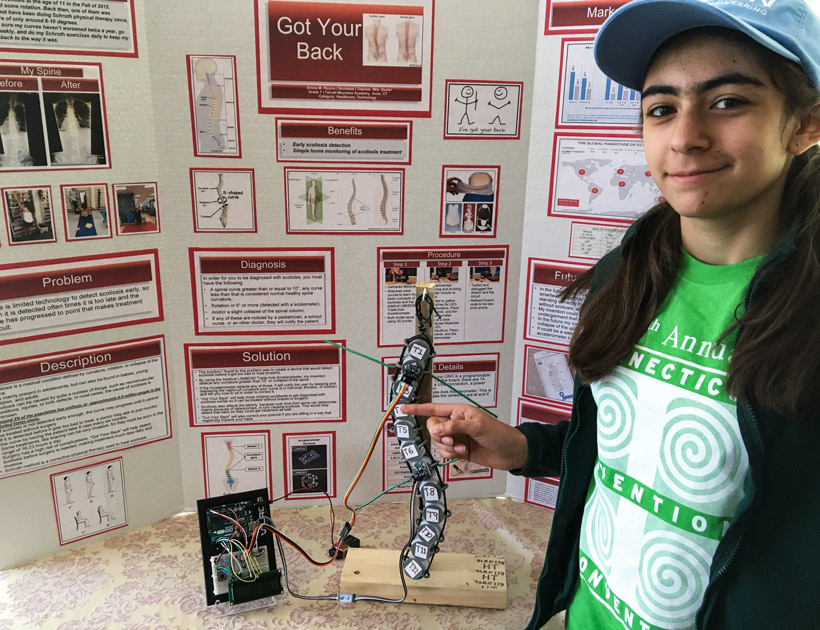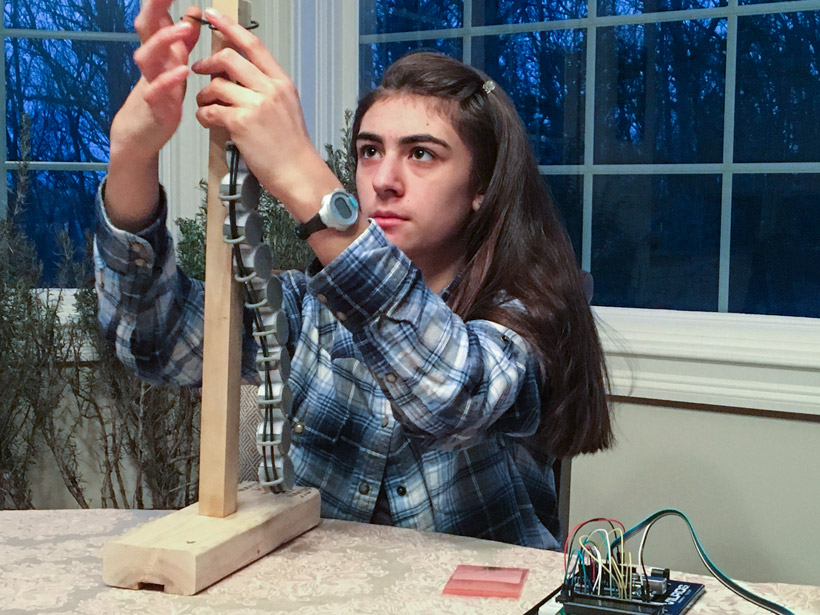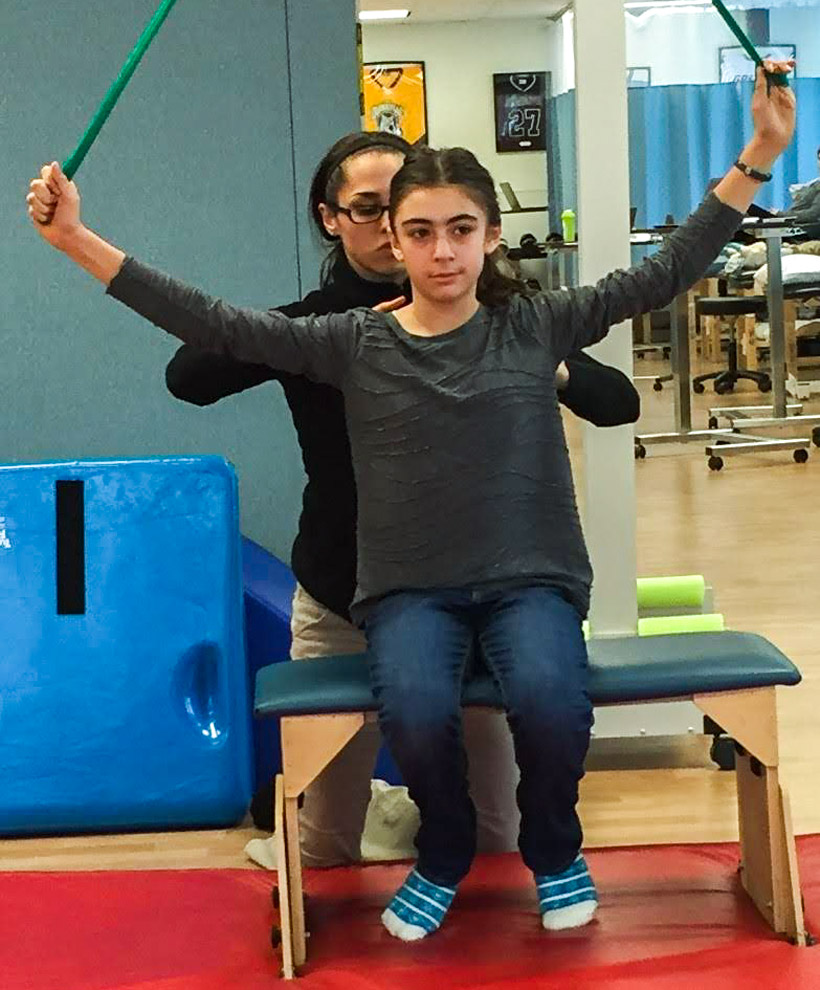When Emma Ruccio was diagnosed with scoliosis, she did what any 11-year-old would naturally do next: she came up with technology to help herself and others improve the effectiveness of their treatment.
Scoliosis is a common health condition. And as it turns out, Emma is an extraordinary young person. After learning of her diagnosis, she decided to develop an alternative to x-rays.
While early diagnosis can impact later quality of life, traditionally, doctors review the topography of a scoliosis patient’s back to calculate curvature — and then, screening and treatment methods pump x-rays through their body repeatedly over the course of years to evaluate whether therapy received is actually helping or hurting. If you feel a bit queasy with that scenario, you’re not alone.
The problem, Emma observed, is that a lot of radiation over a long time can have adverse effects. “I researched x-rays and found out how harmful they are,” she said. “Some people have to get them every three months. That’s a lot of radiation, especially during your teen years.”
It prompted her to ask a very simple, quintessential question at the heart of all innovators:
Is there another way to do this?
Innovation
Emma’s school, the Talcott Mountain Academy, has participated in the Connecticut Invention Convention for years. Emma entered the contest for the first time when she was six. “It never occurred to me that I couldn’t do this,” she quipped in full sincerity.
“I made my first prototype in seventh grade. I used an Arduino with accelerometers.”
During development of her newest idea, Emma researched many imaging technologies. At one point, she even made her way to Columbia University in New York to observe a machine that uses topography to show the mountains and valleys of the human spine. Eventually she discovered infrared.

“I kept hearing about infrared being used for imaging,” she explained. “My first reason for using it was completely wrong,” she reflected. She had been exploring diffused optical tomography, which is used to see differences in tissue density in the brain. So, she thought, why not use it to see the spine. It worked, but not exactly as planned. When the spine curves, it creates muscle tension, which creates heat — it is this heat that the infrared sensor sees, she realized, not tissue density.
“This goes to show that you can have a hypothesis, prove it completely wrong, but still find a solution.”
Working with dogged pursuit, she honed her idea to create a tool she could use at home to see if her therapy was working. A tool that would provide immediate feedback (as compared to every six months), without a mountain of radiation risk.
Persistence
That was merely the tip of the iceberg, Emma discovered. She had a lot of work ahead.

“When I first borrowed the infrared camera from my school, I took pictures but couldn’t see anything. I checked if I had used the camera incorrectly or if it wasn’t working.” Emma was using the camera properly, but still, she was running up against scattering — the camera was picking up heat from other sources, degrading image quality.
Emma used filters to highlight the hottest and coldest parts of her back. She discovered that mirrors are often used to reduce scattering. An infrared heating lamp helped too.
More research and tinkering led to an article that described how cardboard could be used to isolate scattering. For her first prototype, Emma cut a hole in a giant sheet of cardboard and stood behind it. This inspired the design of a vest that would mask her spine … which led to a wave of reengineering with different materials to find just the right porosity.
Emma dove into camera software to edit her images, adjusting saturation and contrast to accentuate the most important parts (See Figure 1). And then she tunneled into deeper analysis.
“Now that I have the pictures, I’m trying to develop a way to measure the curves in the images. The usual measurement is the Cobb angle,” she said, “which is based on the two most tilted vertebra.”

Emma has since turned to machine learning to create the advanced software needed to process her images. She also is looking to continually improve quality. “Some of my images are good, but not as good as x-rays because I am measuring surface heat. I need to measure under the surface.”
Her persistence calls to mind the stories of Thomas Edison trying a thousand materials to find the right filament to use in the light bulb. To date, Emma has captured more than 1,000 images and spent an estimated 1,000+ hours on the project.
Inspiration
In 2018, Emma participated in the National Invention Convention and Entrepreneurship Expo. And won. “Two companies gave me awards,” she said. One of them was Arrow Electronics.

But the sponsors didn’t write Emma checks. Instead, they gave her access to technical services and connected her to people in industry who could help. She spent time dialoguing with experts who could advise on what was realistic and where to go next.
“Having it introduced to me earlier has played a huge role in getting me where I am sooner,” Emma reflected on her journey so far. “I remember my first two years, I was focused on getting recognition, I wanted to win an award. So I kept going back until I was able to get that.”
Competition laid the seeds for deeper passion, and soon Emma realized she was inventing for its own intrinsic reward. It as it turns out, it also gave her a sense for how much she really wants to help people.
Impact
As Emma shows, innovation often arises from a very personal experience. She’s solving a problem that is immediate for her, one she lives with every day. For others, that sort of inspiration may come from wanting to help a grandparent who has mobility issues or a best friend who is deaf.

“I want to help people,” she shared. “That keeps me going. This is the first time I’ve gone this far with an invention. I want to see how far it can go.”
Emma is even entertaining the idea of starting her own business. The more she works on the project, the more her mind turns to entrepreneurship and the idea of scaling something and putting it into the market to give value to a wide audience.
When young innovators are allowed to explore problems they want to solve, and given access to the tools and skill-building they need to be successful, students like Emma learn to control their own destiny … and, potentially, the innovation that will guide us all forward.
Emma’s curiosity and drive are directly impacting her own quality of life — and perhaps someday she’ll touch the lives of millions. It was nurtured by her school, and the encouragement to join an invention contest.
And started with a simple question.
About NICEE
The National Invention Convention and Entrepreneurship Expo (NICEE) is hosted by the STEMIE Coalition (STEM + Invention + Entrepreneurship), which encourages kids to think differently and to believe that their ideas can be created. The STEMIE Coalition was recently acquired by the Henry Ford Museum of American Innovation, which serves as the mecca for people who are interested in invention and innovation. In 2018, Emma won the Arrow Innovation in Electronics Award.

